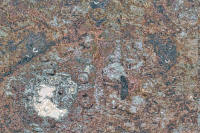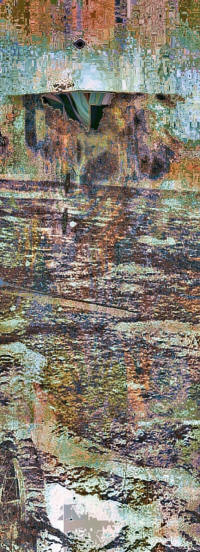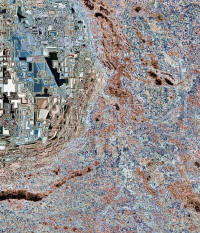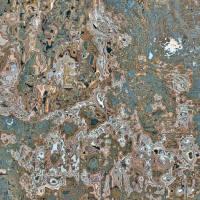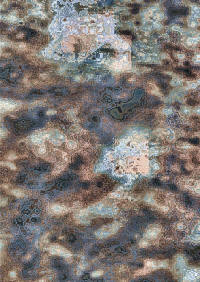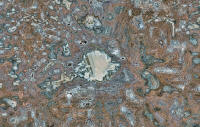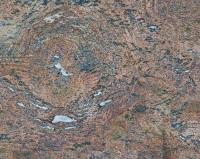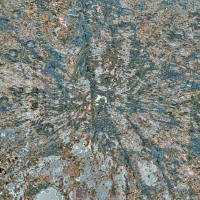|
by Ron Gerbron from RongTolas Website
The Man in the Moon; the God/Goddess/Demon/Hare in the Moon; the Shield of Somebody Important-Moon.
The Moon has a Face, it is Watching us. That last may or may not strike you as a comforting thought. There are lots of permutations, too, but the basic Adamic urge to Put a Name with the (Moon) Face is found in all cultures. It is difficult not to notice it. Also, the close and obvious connection between lunar cycles and plant cycles made the Moon a participant in early agricultural societies, as if it had a will of its own (or a driver) and rated a name.
Of course, as soon as you join a new
group, the gossip starts... The Moon has built up quite a rap sheet.
We shall
begin with the theories put forth way back in 1976 in a most unusual
book, Somebody Else Is On The Moon, by George H.
Leonard.
I agree with most of the conclusions he reached, but for different
reasons.
The mathematics of that sequence of events are quite improbable.
Yet it is the least impossible option. Details on other lunar origin theories can be easily found elsewhere, so we won’t waste much time on them here. The notion of collisions and sundering as the mechanism that formed the Earth is one that periodically gets a new presentation, and is also part of the cosmology of ancient Sumer according to the interpretations of Sitchin.
Let me make a small detour...
He has, however, made a career out of interpreting certain texts in support of his theories about the Anunnaki and human origin. I will discuss his work a little more thoroughly elsewhere, but I should mention his lunar origin theory. The Sumerian Creation story speaks of (surprise) a “War in Heaven”, better called a Celestial Battle, with (here’s where his interpreting starts) several personified proto-planets getting banged into one another and breaking into pieces.
The fragments of one of them, Tiamat, become the Earth and Moon. There is a close pass by Nibiru, planetary home to the Anunnaki, that starts things going.
Nibiru is the “Twelfth Planet”, according to the Sumerians, who (stay with me now) counted out from the Sun and included it and our Moon in their count. It is reputed to have an extended elliptical orbit that takes 3600 years to complete, which furthermore is at an angle to the plane of the ecliptic and therefore to the orbits of all the other planets.
Every other known (admittedly smaller) object in such an
orbit gets tweaked, altered by each pass through the plane, but
Sitchin seems resolute that Nibiru does not. It
does the “drive by” tweaking that wreaks miscellaneous havoc on any
main planet nearby, as it makes its two passes through the plane
each 3600 year cycle. In any event, the problem that no one
seems to bring up is the ad hoc amalgam of myth and cosmology.
I mentioned previously that oral tradition
can preserve specific data very effectively. But when a myth refers
to a god in a “Sun chariot”, it is a metaphor.
If you operate under the assumption that there is actual fact buried
(or encoded, if you prefer) in a particular myth, then you believe
that someone at some time must have understood the real origin. The
interpretation and transformation into a story had to have been done
knowingly. Most supposedly non-fabulous “history” is written this
way, too.
These Anunnaki drank, fought, slept with the local women, and generally behaved completely human. It was technology that set them apart - but even though the locals could not duplicate that technology, they seem to have understood it for what it was. They also seem to have understood the other information that was shared, like the cosmological model that Sitchin outlines in his book, The Twelfth Planet.
Even if his interpretation is a bit, well, interpretive, the ancient Sumerians did seem to have a rather sophisticated and comprehensive understanding of the makeup of the Solar System.
This does not mean
that the Anunnaki were being completely candid and
truthful, by the way. They were a group with an agenda of their own.
But the only detail that concerns us at the present moment is the
notion that there were people around before the Anunnaki (if
you read between the lines) who were able to move planets around.
One more ancient account of a prior age when wonders were possible,
and one which tags the Builders as extraterrestrials,
not spirit beings.
The apparent diameter of the Moon seen from the surface of the Earth is exactly the same as the apparent diameter of the Sun. That seems like one Hell of a coincidence, especially considering how difficult it is to explain how the Moon managed to establish a stable orbit.
The bottom line scientific argument is that it did so,
therefore it must have been possible. Hmm. If you think I am
kidding, go look it up. Each of the four "standard" formation models
carries a disclaimer about its remaining "problems". This of course
delights the Creationists of fundamentalist Christianity, who
are quite willing to embrace the notion that the Moon was placed
there by specific intent.
Well, if you
spin clay on a potter’s wheel, you get a round pot. If that
molten mass was not spinning, why would it form a planetoid anyway?
It would have had to have been rolling, turning perpendicular to the
Earth’s axis, to allow the migration of material that we see.
He would be told “it” was not at that
location, in some other file, labeled with a different stock number
by some other agency and / or his request would be processed if he
applied at another office someplace. This might have simply been
normal government behavior.
While peculiar occurrences and
odd formations are perfectly good fodder for scholarly papers
and grant requests, any suggestion of artificiality or intelligent
design would invalidate the enquiry, removing it from official
consideration. The main tool used for the lunar cover-up has always
been disdain. You don’t see that, because it isn’t there. Behave
yourself.
He states in the preface to his book that:
But he did favor the idea of aliens being responsible, probably more than one type of alien, rather than people from here .
He did not completely rule out the possibility of a clandestine Terrestrial space program, but he felt that since this could not explain the long history of observed Moon anomalies, it was less likely to be a factor. There is a lot that one could read between the lines of his one and only book if one was so inclined. He is one of those authors who occasionally seems to be trying to very subtly imply an additional vector or layer.
This could have
been his way of holding back from making an overly tight fit of the
data into his theories, which he repeatedly cautions are
incomplete, or it could have meant something else. Perhaps there
was more to George H. Leonard than is at first apparent.
No, Hubble can’t look at the Moon... gee, here’s a photo of the full face of the Moon taken by Hubble... well, we’re too busy, yeah, that’s it.
Don’t bother us. Schedules,
you know. So most lunar observation (that we know of) is done
by the amateurs. There have been plenty of probes launched at
the Moon, but except for the Lick Observatory photos
taken in the 1950's there has been relatively little ground based
investigation by major observatories, especially in the U.S. Yes,
that thing up there is the Moon, so what? Hasn’t
changed, has it? Don’t bother us.
As
Richard Hoagland recently
commented, a necessary part of science is speculation. No guts, no
glory.
This frustrated him greatly. No one wanted to really spill the beans, it seemed. They wanted him to do it, but wouldn’t tell him what was there that needed spilling.
The other possibility, which he doesn’t state
directly but which had obviously occurred to him, was that they
didn’t actually have any confidence that they really knew. There
were aliens involved, there was Politics involved, there was
spinning going on. Basic life-advice includes, “Don’t spill while
you are spinning. It can be very messy.”
I’ll save you the bother of going back to puzzle it out from the illustration:
I found that quote on one of the NASA web pages, in a biography they have posted of Verne.
Yes, he was a scientific visionary, and
yes, he had many good and prescient ideas. But the choice of the
quote itself is still a bit ironic, a slightly pompous observation
given in an interview late in his life. It sounds different when NASA says it.
Even before I tell you the name of the author, you may have already been slightly startled by the last four words of it.
But that is of course just the coincidence of contemporary context. Right? The author lived some time ago, in 16th C. Italy.
He was Niccolo Machiavelli.
Oh, you’ve heard of him? Remember, context is everything...
I am not making the blanket statement that he didn’t see what he saw, I’m just pointing out that he wasn’t separating the structural strangeness of the place, something for which he had no contextual basis, from the intrusive things like machines, ships, and possible bases set up by visitors other than the original Builders.
Rather than looking for what he thought he saw, let’s take a look at what is actually up there on that most ancient of artificial satellites.
|
